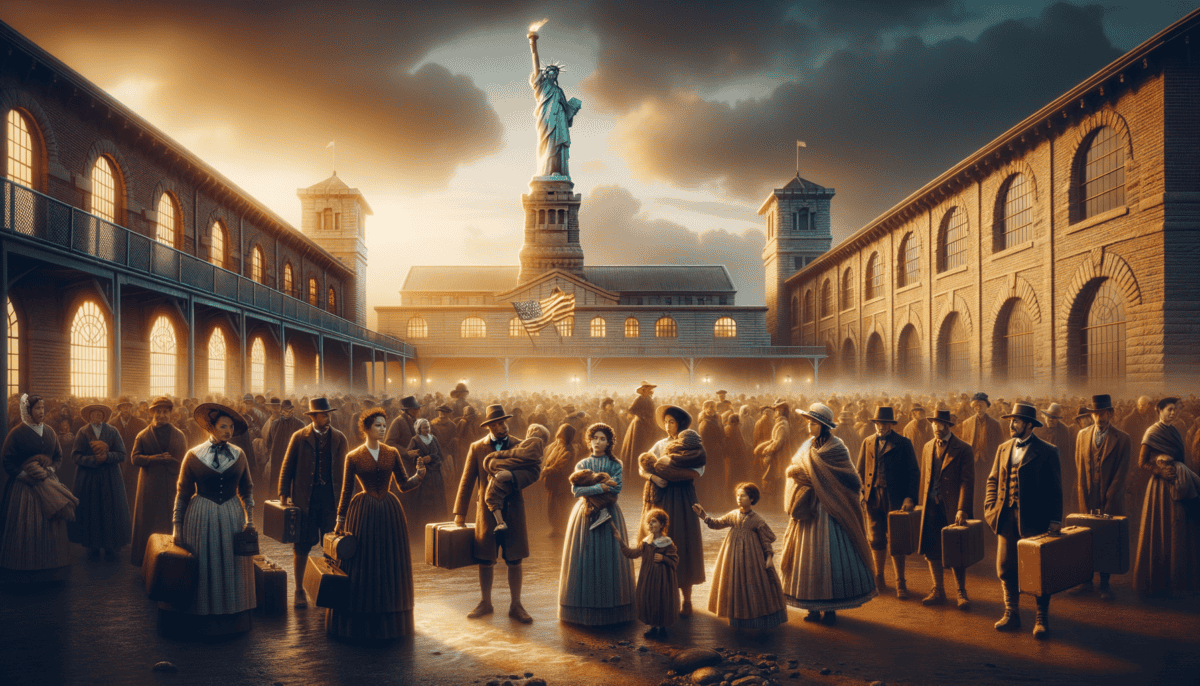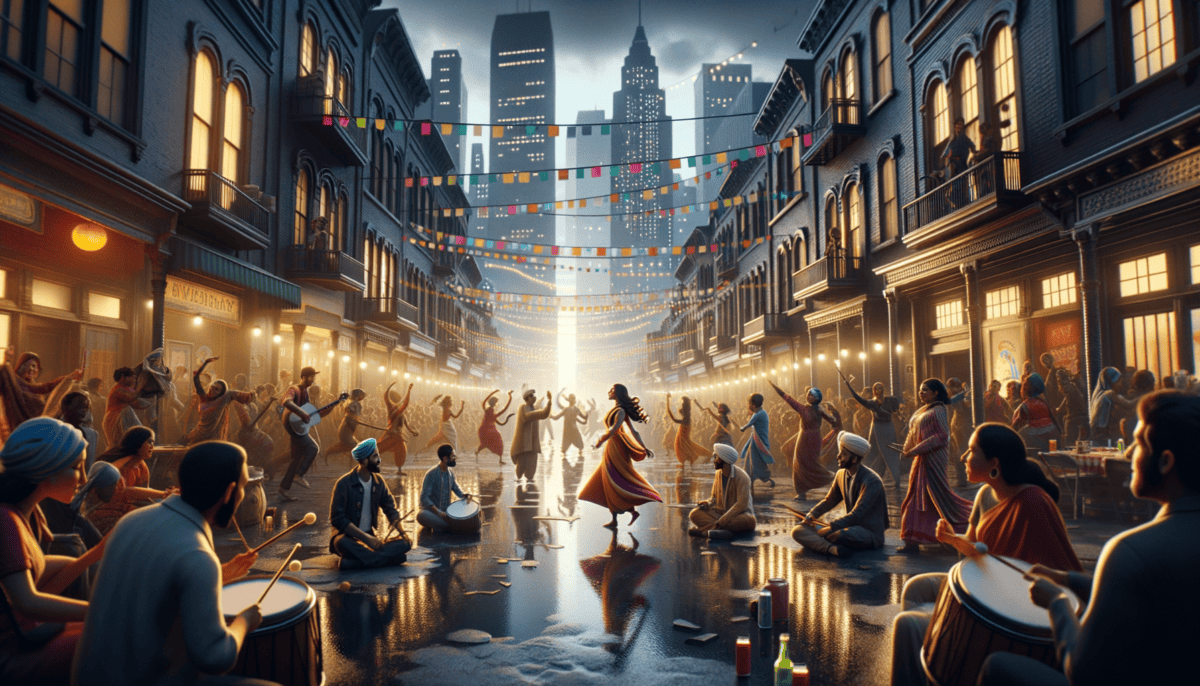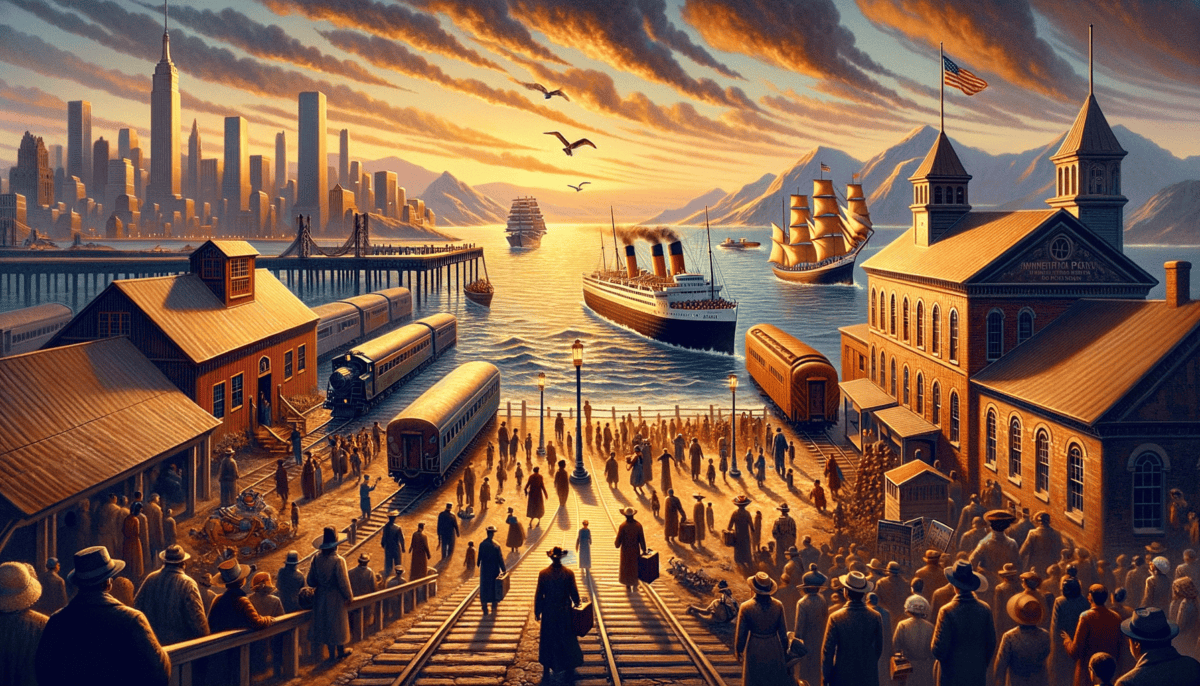First Footsteps – The Earliest Arrivals
Long, long ago, when woolly mammoths still roamed the Earth and ice covered much of North America, brave people made an amazing journey. ️ These first Americans walked across a special land bridge called Beringia that connected Asia to North America.
Little Kaya held her mother’s hand tightly as they walked through the snowy landscape. “Mama, why are we walking so far?” she asked, her feet crunching in the snow.
“We follow the animals, little one,” her mother answered with a gentle smile. “They lead us to food and better places to live.”
Life During the Ice Age
These first people were excellent hunters and gatherers. They made clever tools from stones and bones. They used spears to hunt big animals like:
• Woolly mammoths
• Giant sloths
• Huge bison
• Caribou
Spreading Across the Land
As the ice slowly melted, these brave explorers spread across North and South America. Some settled near the ocean and learned to catch fish. Others made homes in forests or on wide grasslands.
Young hunters learned from their elders how to track animals. “Watch how the deer moves,” a father might tell his child. “See how it leaves marks in the soft ground?”
| Where They Lived | What They Ate |
| Near rivers and lakes | Fish and water plants |
| In forests | Berries and deer |
| On plains | Bison and wild grains |
Building Communities
Over thousands of years, these first Americans created wonderful cultures. They built homes from whatever materials they could find – some used ice blocks, others used wood or mud bricks.
Grandmothers taught their grandchildren stories about their people’s journey. “Our ancestors were brave,” they would say. “They walked across the great ice bridge to find us a new home.”
Children sat around fires at night, listening to tales of how their people first came to this land. They learned songs that told of brave hunters and wise gatherers. The stories helped them remember where they came from.
A Growing Population
As time passed, more and more people lived in North America. They learned to grow food like corn, beans, and squash. They built bigger villages and traded with other groups they met.
“Look at how the corn grows tall,” a mother would teach her children. “This is the way our grandmothers taught us to plant it.”
These first Americans became expert farmers, hunters, and builders. They created beautiful art and told wonderful stories. They were the first people to call this land home, and their descendants still live here today.
Colonial Crossings – European Exploration and Settlement
The year was 1620, and the Mayflower sailed across the big Atlantic Ocean. On board, little Mary looked out at the waves. “Papa, will we really find a new home?” she asked, holding her doll tight.
Why People Came
Many different people came from Europe to America. Some wanted to pray the way they chose. Others wanted to find gold or own their own farms. Some came because they were poor and needed a fresh start.
“In England, we couldn’t worship as we wanted,” Sarah’s mother told her as they prepared for the journey. “In the new land, we can pray our own way.”
| Who Came | Where They Settled |
| English | Massachusetts, Virginia |
| Dutch | New York (New Amsterdam) |
| Spanish | Florida, Southwest |
| French | Louisiana, Canada |
Meeting the Native Americans
When the settlers arrived, Native Americans already lived here. Some helped the newcomers learn important skills. Squanto taught the Pilgrims how to grow corn and find good fishing spots.
Building New Lives
The settlers built homes from logs and started farms. They created small towns that grew bigger and bigger. Each group brought their own ways of cooking, building, and living.
People from these places came to America:
• England
• Spain
• France
• Holland
• Germany
• Sweden
Growing Colonies
As more people came, the colonies grew. They built schools, churches, and markets. Children played games from their old countries and learned new ones from their neighbors.
“Look at all the different foods in the market!” young Thomas exclaimed. “Dutch cookies, English bread, and German sausages!”
Life in the Colonies
Colonial life wasn’t easy. Families worked hard to build homes and grow food. Children helped their parents with chores like:
– Working in gardens
– Helping cook meals
– Carrying water
– Making candles
But they also found time for fun. “Tonight we’ll have a harvest dance,” announced Mother. “Everyone in town will bring food to share!”
A New Kind of Country
These different groups of people helped create something new. Each brought their own special foods, music, and ways of doing things. Together, they started building what would become the United States.
“We may come from different places,” said Grandfather, “but here we can all build a new home together.”
The colonies grew stronger as more people arrived. They brought new ideas and skills that made America special. Each group added their own piece to the big puzzle of American life.
The Great Wave – Through Ellis Island’s Golden Door
Sarah clutched her mother’s hand as their ship approached New York Harbor. The year was 1892, and through the morning fog, a giant green lady appeared. “Mama, look! The Statue of Liberty!”
Welcome to Ellis Island
The big brick building on Ellis Island became known as America’s front door. Every day, ships full of people arrived from countries far away. Some traveled for weeks across the ocean to get here.
“Pick up your bags,” Papa said to little Marco. “Today we become Americans!”
| Where People Came From | What They Brought |
| Italy | Pizza recipes, music |
| Ireland | Stories, dance |
| Poland | Food, crafts |
| Russia | Art, traditions |
A Day at Ellis Island
Each person who arrived had to go through special steps:
– Questions about their name and family
– Skills they could use for work
– Where they planned to live
“Stand in line,” the kind nurse told Maria. “The doctor will check your eyes and throat. Don’t be scared!” ⚕️
New Homes, New Lives
After passing their checks, families moved to different cities and towns. Many stayed in New York, while others took trains to places like Chicago, Boston, or Philadelphia.
Working Hard for Dreams
Many newcomers worked in factories, built railroads, or opened small shops. Children went to American schools and learned English while keeping their family traditions alive.
Growing Together
Different groups lived close to each other in cities. Little Italy, Chinatown, and other neighborhoods grew. Each area had its own special foods, festivals, and customs.
“Smell the fresh bread from the Italian bakery?” Anna’s grandmother smiled. “And listen to the Irish music from next door!”
Making America Stronger
These new Americans helped build cities, start businesses, and share their culture. They taught their children to be proud of both their old and new homes. Their hard work and dreams made America grow bigger and better.
Young David watched his father open their family store. “One day,” his father said, “you’ll have your own American dream too.”
Every person who came through Ellis Island had a story. Some were sad to leave their old homes, but happy to find new ones. They brought their hopes, skills, and courage to help build America’s future.
Fighting for Fairness – Changes in Immigration Rules
The morning sun cast long shadows over Angel Island in San Francisco Bay. Little Ming watched boats sail past, wondering when she could leave. Unlike Ellis Island in New York, many Chinese immigrants were stuck here for weeks or months.
A Time of Closed Doors
“Why can’t we go to America like others?” Ming asked her father. He sighed, touching the wall where other waiting people had carved poems in Chinese characters.
“Some people are scared of things they don’t understand,” he explained. “But we must stay strong and keep hoping.”
World War II Changes Everything
During World War II, many people needed safe places to live. Some countries wouldn’t let them in, but America started to open its doors again.
Fighting for Rights
Brave people worked to change the unfair rules. They marched, wrote letters, and spoke up for people who wanted to come to America. ✊
| Old Rules | New Changes |
| Some groups kept out | More people welcome |
| Unfair treatment | Better chances |
| Long waits | Faster process |
New Laws, New Hope
Little by little, things got better. In 1965, America made a new law that was fairer to everyone. Now people from all countries could come if they followed the rules.
Making Things Right
The main ways people could come to America were:
– Work at special jobs
– Study in schools
– Find safety from danger
Working Together
“Look at our classroom,” Ms. Martinez smiled. “We have friends from everywhere!” Students shared stories about their families’ journeys to America.
Roberto raised his hand. “My grandmother came here for a better life. Now she owns a restaurant!”
Learning from the Past
America learned that keeping people out because of where they came from was wrong. Now, different voices and ideas make the country stronger.
“We’re like a big garden,” explained Mr. Kim to his students. “Every new flower makes it more beautiful.”
Moving Forward
Young people everywhere still dream of coming to America. They want to study, work hard, and help their families. Many bring new ideas that make America better.
Sofia looked at her citizenship certificate proudly. “Now I can help other people follow their dreams too,” she said.
The story of immigration keeps changing. Each new group of people brings fresh hope and energy to America’s big family. They remind us that everyone deserves a chance to make their dreams come true.
New Faces, New Places – America’s Growing Family
Maria stepped off the airplane at JFK Airport, holding her mother’s hand tightly. The year was 1975, and everything looked different from their home in Mexico. “Mira, mamá!” she whispered excitedly, pointing at the tall buildings.
Friends from Far Away
“Welcome to your new home,” smiled Mrs. Johnson, Maria’s teacher. In her classroom, Maria met children from Vietnam, India, and Jamaica. Each had their own special story about coming to America.
“My family came here last year,” said Raj, sharing his samosas during lunch. “Now my dad makes computers!”
New Americans Everywhere
All across America, neighborhoods changed and grew. New restaurants opened with yummy foods from around the world. Different languages filled the streets with happy sounds.
| Before 1965 | After 1965 |
| Mostly European immigrants | People from everywhere! |
| Few Asian families | Many Asian families |
| Limited Latin American immigration | More Latin American neighbors |
Building New Lives
New Americans started businesses, became doctors and teachers, and helped their communities grow. Their children went to school and made new friends.
Special Skills Welcome
Many people came to America because they were good at important jobs. Here’s what they did:
– Take care of sick people
– Build tall buildings
– Teach in schools
– Start new companies
Together in Technology
As computers became more important, smart people from all over the world came to work in places like Silicon Valley. They helped make the internet and smartphones we use today!
Helping Others
Some people came to America to escape danger in their home countries. America gave them a safe place to live and grow. Now they help other new families feel at home.
“When we first came here, our neighbors brought us food,” remembered Kim. “Now my mom cooks Korean food for new families who move in.”
Learning from Each Other
In schools, children shared their special holidays and traditions. They taught each other new games and words from their home countries.
“It’s like having friends from all over the world without leaving your classroom!” laughed Juan.
Growing Together
Today’s America looks different from long ago. You can hear many languages in the streets. You can eat foods from everywhere. You can learn about different ways of living.
“The best part about America,” said Maria, now grown up and teaching her own class, “is that everyone can add their own special color to make it more beautiful.”
As computers and airplanes make the world feel smaller, more people dream of coming to America. They bring their hopes, skills, and dreams to make America even better.
Building Tomorrow Together
Sofia walked through her neighborhood festival, amazed by all the colors, sounds, and smells. Tables filled with foods from around the world lined the street. Children played games from different countries. Music from many cultures filled the air.
A World of Stories
“Tell me your story,” Sofia asked her friend Ahmed, who just moved from Egypt. His eyes lit up as he shared tales of pyramids and his dreams of becoming a doctor in America.
“My parents say America is a place where dreams can come true if you work hard,” Ahmed smiled.
Helping Hands and Open Hearts
All across America, communities work together to welcome new families. Libraries offer books in many languages. Schools help children learn English while keeping their home language. Churches, temples, and mosques open their doors to everyone.
Growing and Learning
| What New Americans Bring | How America Grows |
| New ideas and skills | Better ways to solve problems |
| Different foods and music | More fun things to try |
| Special traditions | Richer culture |
Working Together
Communities find ways to make immigration work better. Here are some things they do:
– Share job opportunities
– Teach each other languages
– Celebrate different holidays
– Help children succeed in school
Challenges and Hope
Sometimes, being new in America isn’t easy. Learning English takes time. Finding a job can be hard. Missing home is normal. But people help each other and work together to solve problems.
Dreams for Tomorrow
Young Americans like Sofia and Ahmed dream big. They want to:
⚕️ Become doctors to help sick people
Teach children from all over the world
Discover new things in science
Create technology that helps everyone
America’s Story Continues
As the sun set on the neighborhood festival, Sofia looked around at all the happy faces. She saw children playing together, grown-ups sharing food, and new friends becoming old friends.
“This is what makes America special,” her grandmother said, squeezing her hand. “It’s like a big family that always has room for more people.”
Looking Forward
The story of immigration in America isn’t over. Every day, new people arrive with hopes and dreams. They join millions of others who came before them, all part of America’s amazing story. Together, they make America stronger, kinder, and more interesting.
As Sofia walked home, she thought about Ahmed’s words about dreams coming true. She smiled, knowing that in America, everyone’s story adds to the bigger picture – like pieces of a beautiful puzzle that keeps growing and changing, making the country more wonderful every day.






